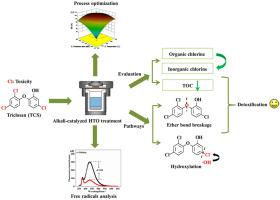Journal of Cleaner Production ( IF 9.7 ) Pub Date : 2021-10-19 , DOI: 10.1016/j.jclepro.2021.129379 Rong Zhang 1 , Rui Shi 1, 2, 3 , Nengmin Zhu 4 , Zhiyong Han 1, 2, 3 , Hongjun Luo 1 , Yushuang Chen 1 , Xinshuo Li 5

|
Due to the lack of green treatment technologies for chlorinated organic contaminant detoxification, in this study, the effect of non-hazardous alkali-catalyzed hydrothermal oxidation (HTO) on triclosan (TCS) was investigated. The optimal parameters determined by single-factor experiments were: a H2O2/TCS (H/T) ratio of 2.5 mL/mg, a temperature of 180 °C, a residence time of 120 min. Using these parameters, the final dechlorination efficiency (DE) of 99.69% was obtained. Response surface methodology (RSM) was employed to further determine the optimal conditions under multi-factor interactions. The optimal parameters were an H/T ratio of 2.5 mL/mg, a temperature of 187 °C, and a residence time of 150 min. The determined DE was 99.47%. The results of three-dimensional excitation-emission matrix (3D-EEM) fluorescence spectroscopy showed that the degradation of TCS generated humic acid-like organics with aromatic ring and phenolic hydroxyl functional groups. Furthermore, fluorescence spectroscopy analysis showed that the residence time increased from 30 to 120 min, and the fluorescence intensity difference increased from 100.5 to 218 au, which confirmed that •OH participated in the alkali-catalyzed HTO process. There were two different reaction pathways: (1) Cleavage of the C–O bond between the two benzene rings, followed by the opening and dechlorination of the benzene ring via oxidation; (2) The benzene rings were directly hydroxylated, opened, and dechlorinated through oxidation. The intermediate products were further oxidized to non-Cl-containing organics, achieving the harmless degradation of TCS. Further analysis showed that the total organic carbon (TOC) removal efficiency was about 80% at a residence time of 140 min, indicating that TCS was almost completely mineralized. This study provides a green and environmentally benign approach for the detoxification of chlorinated organic contaminants.
中文翻译:

三氯生碱催化水热氧化操作变量及降解途径初步评价
由于缺乏氯化有机污染物脱毒的绿色处理技术,本研究研究了无害碱催化水热氧化(HTO)对三氯生(TCS)的影响。单因素实验确定的最佳参数为:a H 2 O 2/TCS (H/T) 比为 2.5 mL/mg,温度为 180 °C,停留时间为 120 分钟。使用这些参数,最终脱氯效率 (DE) 为 99.69%。采用响应面法 (RSM) 进一步确定多因素相互作用下的最佳条件。最佳参数是 H/T 比为 2.5 mL/mg,温度为 187 °C,停留时间为 150 分钟。测定的 DE 为 99.47%。三维激发发射矩阵 (3D-EEM) 荧光光谱结果表明,TCS 的降解产生了具有芳香环和酚羟基官能团的类腐殖酸有机物。此外,荧光光谱分析表明,停留时间从 30 min 增加到 120 min,荧光强度差从 100.5 增加到 218 au,这证实了•OH 参与了碱催化的HTO 过程。有两种不同的反应途径:(1)两个苯环之间的 C-O 键断裂,然后苯环通过氧化开环和脱氯;(2)苯环直接羟基化、开环、氧化脱氯。中间产物进一步氧化为不含Cl的有机物,实现TCS的无害降解。进一步分析表明,停留时间为 140 分钟时,总有机碳 (TOC) 去除效率约为 80%,表明 TCS 几乎完全矿化。该研究为氯化有机污染物的解毒提供了一种绿色环保的方法。有两种不同的反应途径:(1)两个苯环之间的 C-O 键断裂,然后苯环通过氧化开环和脱氯;(2)苯环直接羟基化、开环、氧化脱氯。中间产物进一步氧化为不含Cl的有机物,实现TCS的无害降解。进一步分析表明,停留时间为 140 分钟时,总有机碳 (TOC) 去除效率约为 80%,表明 TCS 几乎完全矿化。该研究为氯化有机污染物的解毒提供了一种绿色环保的方法。有两种不同的反应途径:(1)两个苯环之间的 C-O 键断裂,然后苯环通过氧化开环和脱氯;(2)苯环直接羟基化、开环、氧化脱氯。中间产物进一步氧化为不含Cl的有机物,实现TCS的无害降解。进一步分析表明,停留时间为 140 分钟时,总有机碳 (TOC) 去除效率约为 80%,表明 TCS 几乎完全矿化。该研究为氯化有机污染物的解毒提供了一种绿色环保的方法。苯环经氧化开环脱氯;(2)苯环直接羟基化、开环、氧化脱氯。中间产物进一步氧化为不含Cl的有机物,实现TCS的无害降解。进一步分析表明,停留时间为 140 分钟时,总有机碳 (TOC) 去除效率约为 80%,表明 TCS 几乎完全矿化。该研究为氯化有机污染物的解毒提供了一种绿色环保的方法。苯环经氧化开环脱氯;(2)苯环直接羟基化、开环、氧化脱氯。中间产物进一步氧化为不含Cl的有机物,实现TCS的无害降解。进一步分析表明,停留时间为 140 分钟时,总有机碳 (TOC) 去除效率约为 80%,表明 TCS 几乎完全矿化。该研究为氯化有机污染物的解毒提供了一种绿色环保的方法。进一步分析表明,停留时间为 140 分钟时,总有机碳 (TOC) 去除效率约为 80%,表明 TCS 几乎完全矿化。该研究为氯化有机污染物的解毒提供了一种绿色环保的方法。进一步分析表明,停留时间为 140 分钟时,总有机碳 (TOC) 去除效率约为 80%,表明 TCS 几乎完全矿化。该研究为氯化有机污染物的解毒提供了一种绿色环保的方法。











































 京公网安备 11010802027423号
京公网安备 11010802027423号